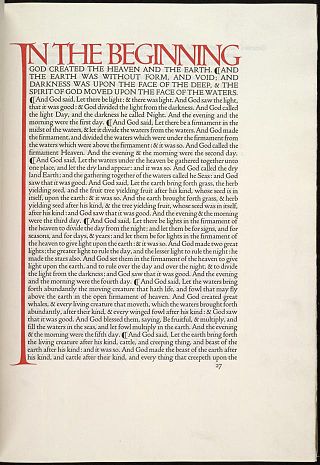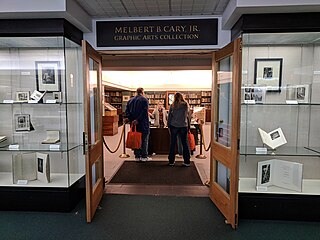Gallery
- Roycroft printing press
- Kelmscott Press font styles
- Albion press used by the Daniel Press
Private press publishing, with respect to books, is an endeavor performed by craft-based expert or aspiring artisans, either amateur or professional, who, among other things, print and build books, typically by hand, with emphasis on design, graphics, layout, fine printing, binding, covers, paper, stitching, and the like.
The term "private press" is not synonymous with "fine press", "small press", or "university press" – though there are similarities. One similarity shared by all is that they need not meet higher commercial thresholds of commercial presses. Private presses, however, often have no profit motive. A similarity shared with fine and small presses, but not university presses, is that for various reasons – namely quality – production quantity is often limited. University presses are typically more automated. A distinguishing quality of private presses is that they enjoy sole discretion over literary, scientific, artistic, and aesthetic merits. Criteria for other types of presses vary. From an aesthetic perspective, critical acclaim and public appreciation of artisans' works from private presses is somewhat analogous to that of luthiers' works of fine string instruments and bows.
The private press movement, and its renowned body of work – relative to the larger world of book arts in Western civilization – is narrow and recent. From one perspective, collections relating to book arts date back to before the High Middle Ages. As an illustration of scope and influence, a 1980 exhibition at Catholic University of America, "The Monastic Imprint," highlighted the influence of book arts and textual scholarship from 1200 to 1980, displaying hundreds of diplomas, manuscript codices, incunabula, printed volumes, and calligraphic and private press ephemera. The displays focused on five areas: (1) Medieval Monasticism, Spirituality, and Scribal Culture, A.D. 1200–1500; (2) Early Printing and the Monastic Scholarly Tradition, ca. 1450–1600; (3) Early modern Monastic Printing and Scholarly Publishing, A.D. 1650–1800; (4) Modern Survivals: Monastic Scriptoria, Private Presses, and Academic Publishing, 1800–1980. [1] [2]
The earliest descriptive references to private presses were by Bernardus A. Mallinckrodt of Mainz, Germany, in De ortu ac progressu artis typographicae dissertatio historica (Cologne, 1639). The earliest in-depth writing about private presses was by Adam Heinrich Lackmann (de) (1694–1754) in Annalium Typographicorum, Selecta Quaedam Capita (Hamburg, 1740). [3]
The term "private press" is often used to refer to a movement in book production which flourished around the turn of the 20th century under the influence of the scholar-artisans William Morris, Sir Emery Walker and their followers. The movement is often considered to have begun with the founding of Morris' Kelmscott Press in 1890, following a lecture on printing given by Walker at the Arts and Crafts Exhibition Society in November 1888. Morris decried that the Industrial Revolution had ruined man's joy in work and that mechanization, to the extent that it has replaced handicraft, had brought ugliness with it. Those involved in the private press movement created books by traditional printing and binding methods, with an emphasis on the book as a work of art and manual skill, as well as a medium for the transmission of information. Morris was greatly influenced by medieval codices and early printed books and the 'Kelmscott style' had a great, and not always positive, influence on later private presses and commercial book-design. The movement was an offshoot of the Arts and Crafts movement, and represented a rejection of the cheap mechanised book-production methods which developed in the Victorian era. The books were made with high-quality materials (handmade paper, traditional inks and, in some cases, specially designed typefaces), and were often bound by hand. Careful consideration was given to format, page design, type, illustration and binding, to produce a unified whole. The movement dwindled during the worldwide depression of the 1930s, as the market for luxury goods evaporated. Since the 1950s, there has been a resurgence of interest, especially among artists, in the experimental use of letterpress printing, paper-making and hand-bookbinding in producing small editions of 'artists' books', and among amateur (and a few professional) enthusiasts for traditional printing methods and for the production 'values' of the private press movement. [4] [5] [6]
In New Zealand university private presses have been significant in the private press movement. [7] Private presses are active at three New Zealand universities: Auckland (Holloway Press [8] ), Victoria (Wai-te-ata Press [9] ) and Otago (Otakou Press [10] ).
A 1982 Newsweek article about the rebirth of the hand press movement asserted that Harry Duncan was "considered the father of the post-World War II private-press movement." [11] Will Ransom has been credited as the father of American private press historiographers. [12]
Beyond aesthetics, private presses, historically, have served other needs. John Hunter (1728–1793), a Scottish surgeon and medical researcher, established a private press in 1786 at his house at 13 Castle Street, Leicester Square, in West End of London, in an attempt to prevent unauthorized publication of cheap and foreign editions of his works. His first book from his private press: A Treatise on the Venereal Disease. One thousand copies of the first edition were printed. [13]
Porter Garnett (1871–1951), of Carnegie Mellon University, was an exponent of the anti-industrial values[ vague ] of the great private presses – namely those of Kelmscott, Doves, and Ashendene. Following Garnett's inspirational proposal to Carnegie Mellon, Garnett designed and inaugurated on April 7, 1923, the institute's Laboratory Press – for the purpose of teaching printing, which he believed was the first private press devoted solely for that purpose. The press closed in 1935. [14]
William Addison Dwiggins (1880–1956), a commercial artist, is lauded for high quality work, namely with Alfred Knopf. And, in contrast to many first-rate book designers joining private presses, he refused. Historian Paul Shaw explained, "He had no patience with those who insisted on retaining hand processes in printing and publishing in the belief that they were inherently superior to machine processes." Dwiggins's "principal concern ultimately centered on readers and their reading needs, esthetic as well as financial. [His] goal was to make books that were beautiful, functional, and inexpensive." [25] [26]

William Morris was a British textile designer, poet, artist, fantasy writer, and socialist activist associated with the British Arts and Crafts movement. He was a major contributor to the revival of traditional British textile arts and methods of production. His literary contributions helped to establish the modern fantasy genre, while he helped win acceptance of socialism in fin de siècle Great Britain.

Frederic William Goudy was an American printer, artist and type designer whose typefaces include Copperplate Gothic, Goudy Old Style and Kennerley. He was one of the most prolific of American type designers and his self-named type continues to be one of the most popular in America.

The Kelmscott Press, founded by William Morris and Emery Walker, published 53 books in 66 volumes between 1891 and 1898. Each book was designed and ornamented by Morris and printed by hand in limited editions of around 300. Many books were illustrated by Edward Burne-Jones. Kelmscott Press books sought to replicate the style of 15th-century printing and were part of the Gothic revival movement. Kelmscott Press started the contemporary fine press movement, which focuses on the craft and design of bookmaking, often using hand presses. While their most famous books are richly decorated, most Kelmscott Press books did not have elaborate decoration, but were published simply.

The Dun Emer Press was an Irish private press founded in 1902 by Evelyn Gleeson, Elizabeth Yeats and her brother William Butler Yeats, part of the Celtic Revival. It was named after the legendary Emer and evolved into the Cuala Press.
Merrymount Press was a printing press in Boston, Massachusetts, founded by Daniel Berkeley Updike in 1893. He was committed to creating books of superior quality and believed that books could be simply designed, yet beautiful. Upon his death in 1941, the Press was taken over by his partner John Bianchi, but ceased operations in 1949. Updike and his Merrymount Press left a lasting impression on the printing industry, and today Updike is considered one of the most distinguished printers of the twentieth century. Stanley Morison, the typographer responsible for creating the ubiquitous Times New Roman, had this to say of the Merrymount Press after Updike's passing: “The essential qualities of the work of the Merrymount Press...may be said without exaggeration…to have reached a higher degree of quality and consistency than that of any other printing-house of its size, and period of operation, in America or Europe.”
Nonesuch Press was a private press founded in 1922 in London by Francis Meynell, his second wife Vera Mendel, and their mutual friend David Garnett, co-owner of Birrell & Garnett's bookshop in Soho's Gerrard Street, in the basement of which the press began.

The Ashendene Press was a small private press founded by St John Hornby (1867–1946). It operated from 1895 to 1915 in Chelsea, London and was revived after the war in 1920. The press closed in 1935. Its peers included the Kelmscott Press and the Doves Press. Hornby became friends with William Morris and Emery Walker, who helped inspire his work. These three presses were part of a "revival of fine printing" that focused on treating bookmaking as fine art. The Ashendene Press was famous for producing high-quality works by Dante. Ashendene books had excellent bindings and focused more on pleasure than reform than the other private presses of the time, though one review claims that the Ashendene Press was the most successful private press in recapturing the essence of fifteenth-century printing. Ashendene books were carefully printed with large margins, and despite their lack of extravagant decoration, they were considered spectacular works of art. Two original typefaces were created for the Ashendene Press: Subiaco and Ptolemy. They were known for handwritten, colored initials by Graily Hewitt. The press' main customers were book collectors who paid for a subscription for Ashendene books.

R.R. Donnelley is an American integrated communications company that provides marketing and business communications, commercial printing, and related services. Its corporate headquarters are located in Chicago, Illinois, United States. In 2007, R.R. Donnelley was the world's largest commercial printer. In 2021, it was referred to as North America's largest.

The Doves Press was a private press based in Hammersmith, London. During nearly seventeen years of operation, the Doves Press produced notable examples of twentieth-century typography. A distinguishing feature of its books was a specially-devised typeface, known variously as the Doves Roman, the Doves Press Fount of Type, or simply the Doves Type.

Walter Samuel Haatoum Hamady was an American artist, book designer, papermaker, poet and teacher. He is especially known for his innovative efforts in letterpress printing, bookbinding, and papermaking. In the mid-1960s, he founded The Perishable Press Limited and the Shadwell Papermill, and soon after joined the faculty at the University of Wisconsin–Madison, where he taught for more than thirty years.
The Story of the Glittering Plain is an 1891 fantasy novel by William Morris, perhaps the first modern fantasy writer to unite an imaginary world with the element of the supernatural, and thus the precursor of much of present-day fantasy literature. It is also important for its exploration of the socialist themes that interested Morris.
Violet De Mars Trovillion (1890–1979) and Hal W. Trovillion (1879–1967) were publishers based in Herrin, Illinois who operated local newspapers and a private press known as Trovillion Private Press at the Sign of the Silver Horse or simply Trovillion Press.
Fine press printing and publishing comprises historical and contemporary printers and publishers publishing books and other printed matter of exceptional intrinsic quality and artistic taste, including both commercial and private presses.

Robert George Collier Proctor, often published as R. G. C. Proctor, was an English bibliographer, librarian, book collector, and expert on incunabula and early typography.

The Cary Graphic Arts Collection is a library and archive of books, type specimens, manuscripts, documents, and artifacts related to the history of graphical communication. Located in Wallace Library at the Rochester Institute of Technology (RIT), in Henrietta, New York, the Cary Collection contains literate artifacts as old as cuneiform tablets and as recent as computer tablets and e-books, in all comprising some 40,000 volumes in addition to manuscripts, correspondence, printing types and traditional letterpress printing equipment.
Lakeside Press was a Chicago publishing imprint under which the RR Donnelley Company produced fine books as well as mail order catalogs, telephone directories, encyclopedias, and advertising. The Press was best known for its high quality editions for the Chicago Caxton Club as well as the Lakeside Classics, a series of fine reprints.

The Golden Type is a serif font designed by artist William Morris for his fine book printing project, the Kelmscott Press, in 1890. It is an "old-style" serif font, based on type designed by engraver and printer Nicolas Jenson in Venice around 1470. It is named for the Golden Legend, which was intended to be the first book printed using it. The original design has neither an italic nor a bold weight, as neither of these existed in Jenson's time.

Edward Philip Prince (1846–1923) was a British engraver and punchcutter, a cutter of the punches used to stamp the matrices used to cast metal type.

Bertha Matilda Sprinks Goudy was an American typographer, fine press printer, and co-proprietor with Frederic Goudy of the Village Press from 1903 until her death in 1935.
The Stratford Press of Cincinnati was the private press of Elmer Frank Gleason (1882–1965), who hand-crafted non-commercial books for libraries, literary clubs, academic institutions, philanthropists, artists, collectors, patrons, and friends.